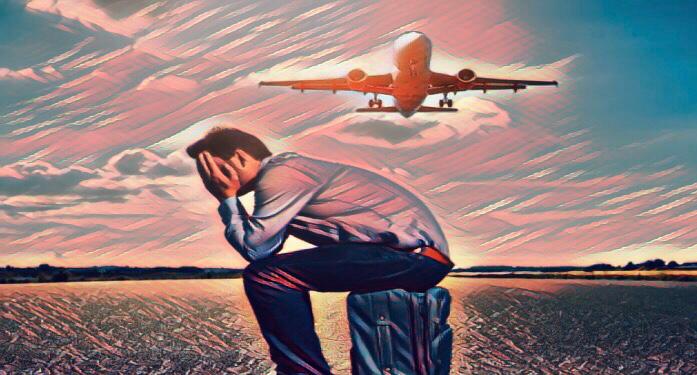Technological advancements, for the most part, aim to save time for modern humans. These advancements are continually developed by R&D departments to be more comfortable and ergonomic, ensuring they are marketable. These improvements allow us to save time comfortably until a better alternative comes along. Take the wheel, for instance—a technological revolution that met our transportation needs. Humans have continually improved it, making it more comfortable and faster until they found a better alternative: flying. So, why wouldn’t we choose this time-saving, hassle-free method of transportation? For one in five people, the answer is fear.
But can you be afraid of flying without ever boarding a plane? Just like we fear lions, tigers, and snakes—predators we rarely encounter but know can harm us—the fear of flying might stem from heights, claustrophobia, or the uncertainty and lack of control when our feet are off the ground.
Despite being statistically the safest mode of transportation, our subconscious doesn’t heed statistics or rational data. The real source of fear is within us, our subconscious. But what if you had to fly frequently for your job? Let’s look at how to handle this and how athletes, who often fly, deal with it.
Take Dennis Bergkamp, for example—a legend of Dutch football and Arsenal, also known as the “Non-Flying Dutchman” due to his fear of flying. Many athletes have struggled with this fear throughout their careers. So, what exactly is fear of flying, and how can we overcome it?

What is Fear of Flying?
Before diving into the stories of athletes with a fear of flying, let’s understand what it is, what causes it, and how to overcome it. Fear of flying, or “Aerophobia” or “Aviophobia,” is an intense fear of flying in an airplane. People can develop this fear for various reasons, such as the thought of the plane taking off, being on the plane, or even the idea of flying itself.
Despite being the safest mode of travel with the fewest accidents and fatalities, the fear isn’t usually about the plane crashing. Instead, it’s about the lack of control and the anxiety of being in a plane. So, what triggers this widespread fear?
Causes of Fear of Flying
As an anxiety disorder, fear of flying often lacks a specific cause. It might stem from childhood anxieties or develop later in life after years of flying without fear. Traumatic triggers during flights can cause this fear, as in the case of Dennis Bergkamp. Examples of such triggers include:
Problems during takeoff or landing
Experiencing or witnessing a violent event or terrorism
Severe turbulence
Onboard incidents like fire or disease outbreaks
Additionally, certain pre-existing anxieties or phobias can exacerbate the fear of flying, such as:
Fear of heights (acrophobia)
Agoraphobia (fear of places where escape might be difficult)
Claustrophobia (fear of confined spaces)
Mysophobia (fear of germs)
Anthropophobia (fear of people)
Thanatophobia (fear of death)
Fear of flying is most common among people aged 17-34. What are its symptoms, and how does it affect those who need to fly frequently, like athletes?
Symptoms of Fear of Flying
Those with a fear of flying may avoid air travel at all costs, missing work meetings, sports events, family vacations, or important events. They might opt for long road, train, or bus trips instead. Fear of flying can lead to:
Shortness of breath and chest tightness
Dizziness and nausea
Heart palpitations and numbness
Stomach discomfort and indigestion
Excessive sweating and trembling
Anxiety and fear at the thought of booking a flight, going to the airport, or boarding a plane
Persistent feelings of dread and fear of death
These symptoms can last days before or after a flight. How do athletes, who frequently need to travel, cope with this fear?

Athletes with Fear of Flying
Dennis Bergkamp
A legend in Dutch football and an Arsenal icon, Dennis Bergkamp is famously known as the “Non-Flying Dutchman” due to his fear of flying. This fear stemmed from traumatic experiences. In 1989, at just 20 years old, Bergkamp lost two teammates in a plane crash. He narrowly avoided the crash by taking an earlier flight. This event deeply affected him, and despite his aversion to flying, he continued to do so until 1994, when multiple incidents during the World Cup exacerbated his fear. He ultimately vowed never to fly again, earning fines and missing several away matches.
Royce White
Drafted with high hopes by the Houston Rockets, Royce White, selected 16th overall in the NBA draft, never played a regular-season game due to his fear of flying. Diagnosed with generalized anxiety disorder and obsessive-compulsive disorder, White’s anxiety was amplified during flights, leading to panic attacks. After unsuccessful negotiations with the Rockets for support, he was traded and eventually left the NBA, unable to manage the frequent flying required.
Wayne Gretzky
Considered one of the greatest NHL players, Wayne Gretzky also struggled with a fear of flying early in his career. His teammate, Ace Bailey, provided significant support, calming him during flights. Tragically, Bailey later died in the 9/11 attacks, a loss that deeply affected Gretzky.
Jerome Haehnel
Tennis player Jerome Haehnel, who defeated Agassi and Federer and won the 2004 Open de Moselle, struggled with a fear of flying. This fear limited his career progression as he avoided flights, especially to less developed and distant locations. Despite hating to fly, Haehnel had to cancel many matches due to his growing anxiety.
Paul Merson
Known for his time at Arsenal and other clubs, Paul Merson had a well-documented fear of flying. Despite a successful career with over 600 appearances and 126 goals, Merson preferred traveling by train for away games due to his fear.
Paolo Guerrero
Peru’s top scorer, Paolo Guerrero, has had a successful career with teams like Bayern Munich and Flamengo. However, his fear of flying, likely stemming from a 1987 crash that killed his uncle, has been a constant challenge. He expressed fear of flying and the anxiety it caused.
Muhammad Ali
The legendary boxer Muhammad Ali, famous for his “float like a butterfly” quote, also feared flying. However, he overcame this fear later in life, believing divine protection would prevent him from dying in a crash.
Cortland Finnegan
American football player Cortland Finnegan admitted to a severe fear of flying, preferring long ship voyages over flights and requiring tranquilizers for air travel.
Matias Delgado
Known in Turkey for his time with Beşiktaş, Matias Delgado’s fear of flying and heights kept him from away matches. He sought treatment in Switzerland, including simulator sessions like those used in pilot training, to overcome his fear.
Bobby Fischer
Chess legend Bobby Fischer’s fear of flying stemmed from paranoia, believing the KGB would target him.
Sports-Related Plane Crashes
Despite being the safest mode of travel, the rare but catastrophic nature of plane crashes leaves a lasting impact. Notable crashes include:
The 1958 Munich crash killing 23, including 8 Manchester United players.
The 1993 crash killing the entire Zambian national team.
The 2016 Chapecoense crash, killing 77 and deeply affecting the sports world.
Leicester City’s owner Vichai Srivaddhanaprabha’s death in a 2018 helicopter crash.
Argentine player Emiliano Sala’s 2019 crash while transferring from France to England.
The tragic 2020 helicopter crash that claimed basketball legend Kobe Bryant and his daughter.
With an estimated one in five people experiencing fear of flying, how can they cope with it?

Overcoming Fear of Flying
There’s no specific diagnostic test for fear of flying, but symptoms and thoughts can indicate it. Avoiding stimulants like caffeine, drugs, or alcohol, and sharing fears with loved ones for support can help manage anxiety. Consulting a specialist and undergoing psychotherapy often provide significant relief. Here’s how to tackle it:
Cognitive Behavioral Therapy (CBT): CBT helps address anxious thoughts about flying, educating on aircraft operation, and comparing the safety of air travel to other modes. Techniques include breathing exercises and meditation to manage anxiety during takeoff, landing, or turbulence. Confronting negative thoughts and understanding their origins (like past trauma) can also help.
Exposure Therapy: This involves gradual exposure to the fear, calming the limbic system and reducing quick-trigger anxiety. Visiting airports, watching planes take off and land, and using flight simulators or virtual reality tools can help. Think of it as climbing a ladder of fear.
Psychotherapy helps many people, including athletes, overcome fear of flying. Onboard, engaging in calming activities like music, reading, or talking to cabin crew can ease anxiety. Remember, flying is the safest mode of travel, and with the right steps, you can overcome your fears.







